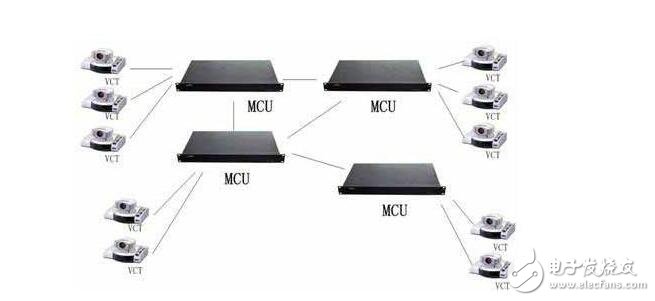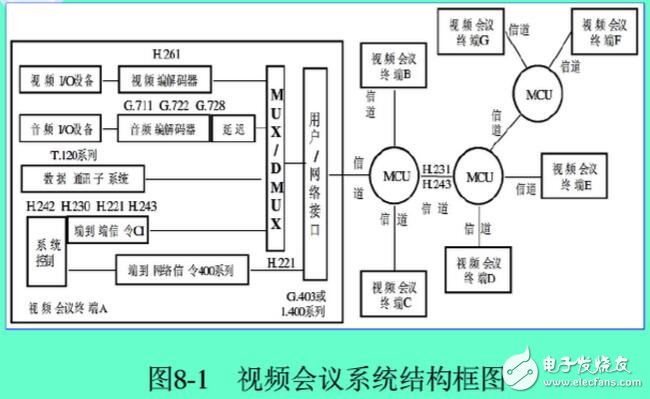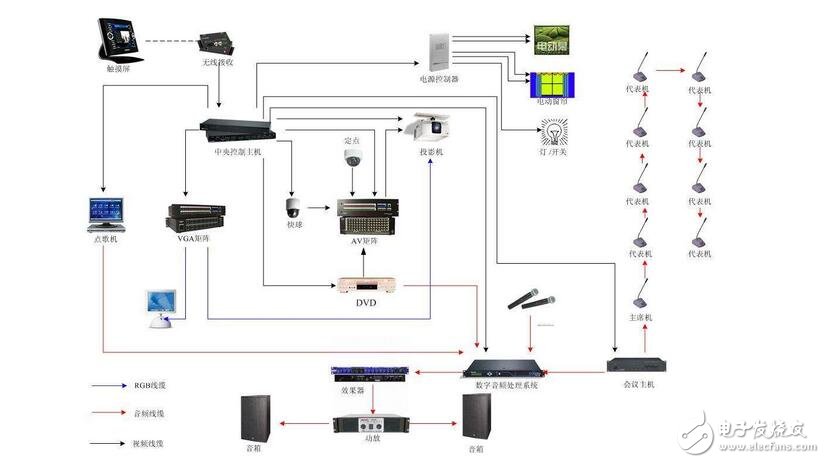In order to implement a multipoint conference television system, an MCU must be set up. The MCU is essentially a multimedia information exchange, which performs multi-point calling and connection, realizes functions of video broadcasting, video selection, audio mixing, data broadcasting, etc., and completes the connection and switching of each terminal signal. The MCU differs from the current switch in that the switch completes the point-to-point connection of the signal, while the MCU completes the multi-point-to-multipoint switching, tandem or broadcast.

1. MCU (MulTI-point Control Unit) The core part of the video conference. Coordinate and control video transmission between multiple terminals.
There are two components: MC (MulTIpoint Controller) and MP (MulTIpoint Processor). The MC is mainly responsible for coordinating the sequence of transmission channels between terminals and using H.245 to define the specifications of the transmission content; MP is actually engaged in the reproduction and transfer of audio and video under the control rules of the MC. And the processing of some video streams. In the MCU, the MC is a management function that must be provided, and the MP has a choice between the terminal's ability to handle the video and the overall environment architecture.
2, the composition of the video conference

The composition of the conference system is very simple. Each conference site is equipped with a video conference terminal. The terminal is connected to the television as an echo device and connected to the network as a transmission medium. A terminal usually has a core codec, a camera, an omnidirectional microphone, and a remote control. The core codec transmits the image and sound input from the camera and microphone through the network, and at the same time decodes the data transmitted from the network and restores the image and sound to the TV and the sound, realizing real-time interaction with the remote end. The terminal connects by calling the IP address or ISDN number (the line does not need to dial). However, in the case of three points, the MCU (Video Conferencing Multipoint Control Unit) must be used for management.
Similar to the telephone exchange, the MCU (Multi-Point Control Unit) is used to determine which way (or which four channels are combined into one) to be broadcast as the main image for more than three points of the video conference. The sound of all venues is synchronized in real time. In the conference system with the MCU video conference system terminal, the audio and video data of all terminals are transmitted to the MCU for selective broadcast in real time. The MCU has a large data flow, and is usually connected to the central switch of the network. The controller uses the MCU management interface of the laptop to remotely manage the site. The calling mode may be called by the control personnel by the MCU to each terminal, or the terminal may call the set conference number.
If the network of the video conference system planned by the customer is relatively large, another video conference network can be established under the MCU, and the MCUs of the two networks implement video and audio exchange, and this method is called cascade connection of the MCU. For example, the bandwidth of the video conferencing network from the central to the provinces is 2M, and the province itself has its own video conferencing system. The central meeting uses its own MCU to save the meeting and use the provincial MCU. When it is necessary to upload and release, the MCU level can be connected. The advantage of cascading is that management will not be confusing; second, the bandwidth to the central area does not allow the data of dozens of points below to be squeezed into it.
What is an MCU?
In order to implement a multipoint conference television system, an MCU must be set up. The MCU is essentially a multimedia information exchange, which performs multi-point calling and connection, realizes functions of video broadcasting, video selection, audio mixing, data broadcasting, etc., and completes the connection and switching of each terminal signal. The MCU differs from the current switch in that the switch completes the point-to-point connection of the signal, while the MCU completes the multi-point-to-multipoint switching, tandem or broadcast.
The role of the MCU
The role of the MCU is to switch the input multi-way conference television signal, but since the conference television signal contains three different types of signals: image, voice and data, the switching effect of the MCU is not as simple as the telephone exchange. The signal is switched, and it has to deal with the three types of signals differently. The MCU adopts a multi-channel mixing mode (of course, can also adopt a switching mode) to transmit the voice signal, and directly transmits the video signal, and transmits the data signal in a broadcast mode or an MLP mode. In addition, the MCU also completes the processing of communication control signals and network interface signals.

Industry definition of video conferencing MCU:
An MCU is a physical entity. For the cuboid, the appearance is generally similar to a butterfly machine. MCUs cannot be used independently. Must be used in conjunction with a video conferencing terminal.
The MCU is mainly divided into two parts, namely MC (MulTIpoint Controller) and MP (Multipoint Processor). MCU Chinese name is multi-point control unit, also known as single-chip microcomputer (SingleChipMicrocomputer), refers to the computer's CPU, RAM, ROM, timer and various I/ with the emergence and development of large-scale integrated circuits. The O interface is integrated on a chip to form a chip-level computer, which can be controlled differently for different applications!

The MCU mainly deals with three types of data:
1. Video signal: mainly completed by video processor
The MCU generally uses a direct distribution method for food signals. If a conference site is spoken, its image signal is transmitted to the MCU, and the MCU switches it to all other conference sites connected to it. If each conference site needs to simultaneously view images of multiple field points (multi-window system or multi-monitor system), the MCU's video processor mixes the multiple video signals.
2. Audio signal: mainly done by the audio processor.
If there is only one conference site to speak, the MCU switches its audio signal to other conference venues. If several conference venues speak at the same time, the MCU selects an audio signal according to the conference control mode and switches it to other conference venues.
The audio processor consists of a voice transcoder and a voice mixing module. The former separates various speech signals from the frame structure of the data stream input by each port, decodes them, and then sends them to the speech mixer for linear superposition, and finally sends them to the encoder to form a suitable coding form, which is inserted into the output. In the data stream.
3. Data signal: mainly completed by the data processor.
The MCU uses the broadcast method to switch the data of a certain conference site to other conference sites. This is mainly used for the chairman control mode. In addition, the network interface module and the control processor in the MCU structure are also indispensable. The network interface module divides the input and output directions. The module corrects the input data stream and the output data stream, and locates the input data stream according to the clock of the local system. Input various required signaling and information, form channel frames, in the output direction of the interface module for output to the digital channel of the communication network. The control processor is primarily responsible for determining the correct routing, mixing or switching audio, video, data signals, and controlling the conference.
MCU is the key to multipoint video conferencing systems:
The role of the MCU is equivalent to the role of a switch, but it is not the same as the switch in the general telephone network. The former switches the digital signal while the latter switches the analog signal. The MCU extracts the information and signaling of audio, video, data, etc. from the information flow of each conference site, and then sends the information and signaling of each conference site to the same processing module to complete the corresponding The process of audio mixing or switching, video mixing or switching, data broadcasting and routing, timing and conference control, and finally reassembling the various information required for each conference site and sending it to each corresponding terminal system device.
The MCU also has the function of automatically unifying the transmission rate: all terminal systems of the same conference should work at the same rate. If the rate of the terminal connected to it is inconsistent, it will automatically select the lowest rate of all terminal systems as the working rate.
The MCU is used to support conferences of more than three node devices, and point-to-point communication does not require access. In the H.323 system, an MCU consists of a multipoint controller MC and several multipoint processors MP, but may also not contain the H.245 control information between the NP.MC processing terminals, thereby determining its video and The usual processing power of audio. If necessary, the MC can also control conference resources by determining which video streams and audio streams require multicast. The MC does not directly process any media stream and leaves it to the MP for processing. The MP mixes, switches, and processes audio, video, or data information. MCs and MPs may exist in a dedicated device or as part of other H.323 components.
Boiler Pressure Gauge,Inflatable Pump Pressure Gauge,Mini-Sized Theromanometer Pressure Gauge,Gauge Pressure
ZHOUSHAN JIAERLING METER CO.,LTD , https://www.zsjrlmeter.com